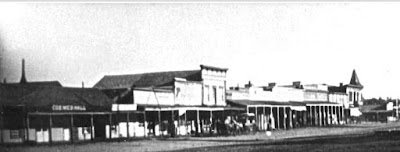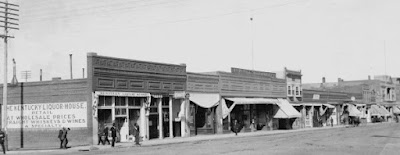Foreword: The main thoroughfare of Prescott, Arizona, Montezuma Street, is called “Whiskey Row” because of the large number of saloons that once lined it. Beginning in the mid-1800s the street, shown below, harbored a considerable number of drinking establishments. After a disastrous fire wiped out much of Whiskey Row in July 1900 and was rebuilt, the numbers actually increased. At one point the strip boasted at least 40 saloons. Here is the story of three “whiskey men” who helped make Prescott’s Whiskey Row the legend it is today.
 |
| The Original Whiskey Row |
 Born in New York about 1829, Dan Thorne came West about 1850 with thousands of men joining the California Gold Rush and later migrated to Arizona. Although Thorne seem to have prospered through his mining enterprises, he also saw the possibilities for riches in operating a saloon in Prescott. As early as 1869 he was associated with the Palace Bar and the Cabinet Saloon, two of Prescott’s most famous watering holes. With a partner he built a large frame building and opened the Cabinet, described as a “new resort.” The owners displayed minerals and published ads inviting prospectors to bring in specimens for cash.
Born in New York about 1829, Dan Thorne came West about 1850 with thousands of men joining the California Gold Rush and later migrated to Arizona. Although Thorne seem to have prospered through his mining enterprises, he also saw the possibilities for riches in operating a saloon in Prescott. As early as 1869 he was associated with the Palace Bar and the Cabinet Saloon, two of Prescott’s most famous watering holes. With a partner he built a large frame building and opened the Cabinet, described as a “new resort.” The owners displayed minerals and published ads inviting prospectors to bring in specimens for cash.
 Although over the years it was the scene of a few violent encounters, perhaps the best story from Thorne’s Cabinet Saloon occurred on a snowy night in January 1898 when a veiled woman dropped a baby girl on the bar and then disappeared out the swinging doors into the dark. The local Courier newspaper told it this way: "All other business was brought to a standstill while the crowd gathered around the bar where the little one had been deposited. As it was impossible for all to get near, one of the employees got up and explained the situation and read the note left with the baby."
Although over the years it was the scene of a few violent encounters, perhaps the best story from Thorne’s Cabinet Saloon occurred on a snowy night in January 1898 when a veiled woman dropped a baby girl on the bar and then disappeared out the swinging doors into the dark. The local Courier newspaper told it this way: "All other business was brought to a standstill while the crowd gathered around the bar where the little one had been deposited. As it was impossible for all to get near, one of the employees got up and explained the situation and read the note left with the baby."
The unsigned note said the father, a miner named William Bell, had abandoned the baby, and the child was now being returned to him by way of the Cabinet, a place he frequented. Bell was not there that night, but the miners, ranchers and railroad hands present, their emotions apparently loosened by whiskey, were so taken with the chubby, cooing infant that they cooed right back at her and some wanted to adopt her. A local probate judge named Charles Hicks cradled the infant in his arms and took her home to his wife. They decided to called her Violet. This orphan girl, legally adopted, became Violet Hicks, learned to ride horses before she could walk and found a loving home with a previously childless couple.
On the morning of July 5 a fire broke out in the kitchen of Thorne’s saloon. According to the July 7 Arizona Gazette: “Volumes of smoke poured from the doors and windows and soon the flames were seen issuing not only from the roof of Thorne’s, but from the eaves of the neighboring buildings so rapid was their progress.” A saloon across the street had to be dynamited to prevent the flames from jumping across. The explosion was a success and that block was saved. But the fire had roared down the other side of Whiskey Row destroying not only the Cabinet Saloon but the Palace Bar and other establishments. Thorne and other saloonkeepers set up shop in tents.
Almost immediately Thorne with others agreed to collaborate on rebuilding the block including both the Cabinet and Palace Saloons. Instead of constructing again with combustible wood, the new buildings were made of brick, granite and iron. The new Palace was estimated to cost an unheard-of $50,000 and restoring the Cabinet likely involved a similar figure. Over the next several years Thorne, now in his 70s, sold his Prescott saloons and moved back to New York City where he died in March 1913.
 |
| Whiskey Row Rebuilt |
Unlike Thorne, Hugh McCrum was a rich man by the time he arrived in Prescott. This immigrant from Northern Ireland was virtually penniless when he reached America in 1850 and went west to find his fortune. Although his original stake came from mining, McCrum also had a penchant for running saloons, selling liquor in Western towns like Virginia City, Nevada; Tombstone, Arizona, San Francisco and Los Angeles.
McCrum increasingly was drawn to Arizona, particularly the area around Prescott. There were two attractions, mining and saloons. From early on McCrum was checking out area mines, telling newsmen that he believed the mineral resources of Arizona to be almost inexhaustible and would prove equal if not superior to the mines of California. He also was calculating the profitability of the numerous saloons on “Whiskey Row,” shown here, eventually buying up several with his riches.
The Phoenix Gazette called him “…One of the oldest mining men on the coast and his judgment is taken above all. He has traveled through the mining regions on the coast for thirty years and none are better known.” McCrum had reported to the paper on his mining efforts twenty miles south of Prescott, claiming his works were “running night and day on good gold ore.”
 Famous for his peripatetic ways, roaming the West, McCrum seems to have been popular in Prescott. When he married for the second time in Los Angeles in 1885, the Prescott Journal Miner hailed his new bride as “a most excellent lady” and joined McCrum’s reputed “army of friends in Arizona,” in extending congratulations. Meanwhile he was not neglecting his mining interests
Famous for his peripatetic ways, roaming the West, McCrum seems to have been popular in Prescott. When he married for the second time in Los Angeles in 1885, the Prescott Journal Miner hailed his new bride as “a most excellent lady” and joined McCrum’s reputed “army of friends in Arizona,” in extending congratulations. Meanwhile he was not neglecting his mining interests
 During this period McCrum changed his official residence to Prescott. Although he continued to own drinking establishments on Whiskey Row, he kept strong ties in California where he owned considerable property. I can find no report of how his saloons fared in the 1900 conflagration. McCrum was in San Francisco when he died at the age of 66 in July 1902. Shown here is his mausoleum.
During this period McCrum changed his official residence to Prescott. Although he continued to own drinking establishments on Whiskey Row, he kept strong ties in California where he owned considerable property. I can find no report of how his saloons fared in the 1900 conflagration. McCrum was in San Francisco when he died at the age of 66 in July 1902. Shown here is his mausoleum.
When F. G. McCoy came to Prescott in 1902, the rebuilt Whiskey Row already was in full swing. With a relative, McCoy established the Wellington Saloon at 136 South Montezuma, between the Palace at 122 and the Owl Saloon at 138. Unlike many of his fellow Whiskey Row neighbors, McCoy was not just selling liquor as received from wholesalers. He also was decanting whiskey into flask-sized bottles for retail sales, shown here.
Each Whiskey Row saloon had its own regulars — cowboys, miners, soldiers or businessmen — and each had its own attractions. McCoy’s Wellington Saloon encouraged gambling on premises. A local artist caught the action of a game of chance there. From the dress of the gents in the Wellington picture, McCoy’s clientele were from the local business community. They were shown playing faro. That was a card game, more related to blackjack than poker, popular in the Old West for its fast action, simple rules, and better odds than other games.
McCoy’s tenure at the Wellington, however, proved to be relatively short. By 1907, the saloon was no longer listed in directories. The reason may have been Arizona’s off-and-on flirtation with prohibiting alcohol sales. In 1901 a “local option” law was passed permitting individual counties and towns to decide on how to regulate alcohol. Although no evidence exists that Prescott went “dry,” McCoy may have felt it affected his business in adjacent towns. The law was repealed in 1909.
By 1912 McCoy surfaced again in the saloon business. This time he was recorded as running a Prescott saloon with F. C. Whisman. Frank Whisman had been a Prescott bartender, likely working at the Wellington Saloon. The partners called their enterprise simply “McCoy & Whisman.” It was a short-lived drinking establishment, forced to shut down when Arizona voters in 1913 approved a statewide ban on alcohol that went into effect on New Years Day, almost six years before National Prohibition. During the twenty superficially “dry” years in Prescott, F. G. McCoy faded into the mists of time.
Note: More extensive posts on each of these three men may be found elsewhere on this website: Dan Thorne, August 26, 2016; Hugh McCrum, September 19, 2016; and F. G. McCoy, April 4, 2016.





No comments:
Post a Comment